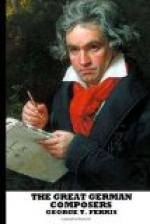The first radical development of Wagner’s theories we see in “The Flying Dutchman.” In “Tanhhaeser” and “Lohengrin” they find full sway. The utter revolt of his mind from the trivial and commonplace sentimentalities of Italian opera led him to believe that the most heroic and lofty motives alone should furnish the dramatic foundation of opera. For a while he oscillated between history and legend, as best adapted to furnish his material. In his selection of the dream-land of myth and legend, we may detect another example of the profound and exigeant art-instincts which have ruled the whole of Wagner’s life. There could be no question as to the utter incongruity of any dramatic picture of ordinary events, or ordinary personages, finding expression in musical utterance. Genuine and profound art must always be consistent with itself, and what we recognize as general truth. Even characters set in the comparatively near hack-ground of history are too closely related to our own familiar surroundings of thought and mood to be regarded as artistically natural in the use of music as the organ of the every-day life of emotion and sentiment. But with the dim and heroic shapes that haunt the border-land of the supernatural, which we call legend, the case is far different. This is the drama of the demigods, living in a different atmosphere from our own, however akin to ours may be their passions and purposes. For these we are no longer compelled to regard the medium of music as a forced and untruthful expression, for do they not dwell in the magic lands of the imagination? All sense of dramatic inconsistency instantly vanishes, and the conditions of artistic illusion are perfect.
“’Tis distance
lends enchantment to the view,
And clothes the mountains
with their azure hue.”
Thus all of Wagner’s works, from “Der fliegende Hollander” to the “Ring der Nibelungen,” have been located in the world of myth, in obedience to a profound art-principle. The opera of “Tristan and Iseult,” first performed in 1865, announced Wagner’s absolute emancipation, both in the construction of music and poetry, from the time-honored and time-corrupted canons, and, aside from the last great work, it may be received as the most perfect representation of his school.
The third main feature in the Wagner music is the wonderful use of the orchestra as a factor in the solution of the art-problem. This is no longer a mere accompaniment to the singer, but translates the passion of the play into a grand symphony, running parallel and commingling with the vocal music. Wagner, as a great master of orchestration, has had few equals since Beethoven; and he uses his power with marked effect to heighten the dramatic intensity of the action, and at the same time to convey certain meanings which can only find vent in the vague and indistinct forms of pure music. The romantic conception of the mediaeval love, the shudderings and raptures




